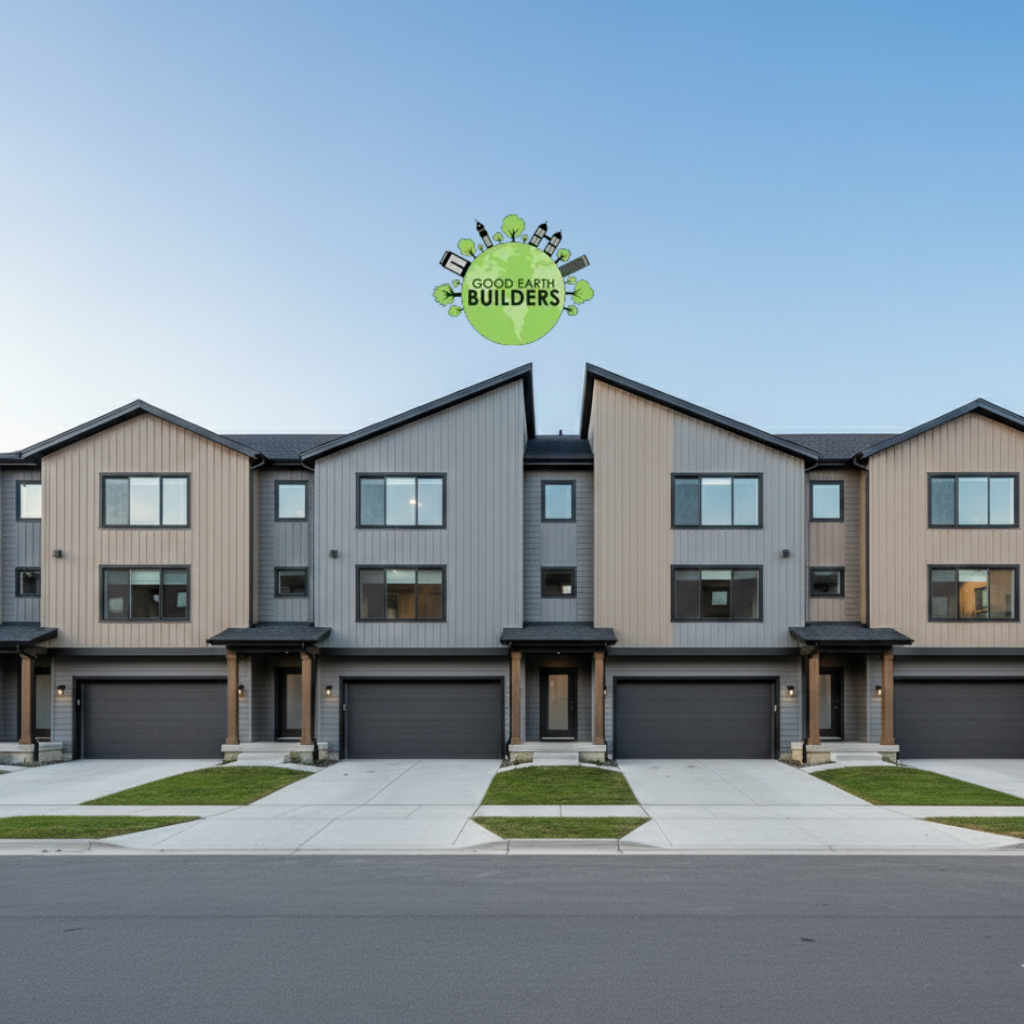Monday, October 6, 2025
In the rapidly evolving landscape of Calgary real estate, infill row home development has cemented its position as the premier strategy for urban revitalization and maximizing land value. Row homes, also known as attached townhomes, offer a perfect blend of higher density, individualized street presence, and a low-maintenance, inner-city lifestyle highly coveted by modern buyers.
However, moving a project from a single-family lot to a successful, multi-unit row home development is a marathon, not a sprint. It demands an intimate knowledge of local municipal processes, strict adherence to technical construction codes, and a finely tuned financial model. This extensive, four-part guide provides experienced developers and ambitious investors with the detailed, step-by-step blueprint required to master this complex process, turning municipal zoning mastery into guaranteed profit.
Part I: The Foundation—Zoning, Land Acquisition, and Advanced Feasibility 🏗️
Success in Calgary infill is determined long before the first shovel hits the dirt. It starts with strategic land selection and a deep understanding of the city’s land use regulations.
1. Decoding Calgary’s Crucial Infill Zones: R-CG Explained
The single most critical variable in row home development is the Land Use Bylaw (LUB) classification. For multi-unit infill in established communities, the focus is unequivocally on the R-CG (Residential Grade-Oriented Infill) District.
The shift towards R-CG reflects Calgary’s desire to facilitate higher-density, contextually sensitive housing. Unlike older zones like R-C2, which typically limit development to duplexes and single-detached homes, R-CG explicitly allows for the construction of rowhouses, fourplexes, and semi-detached units—often all on the same site plan. This flexibility is what unlocks maximum profitability.
| Zoning Feature | R-CG (Grade-Oriented Infill) | Why It Matters for Profit |
| Allowed Unit Types | Single, Semi-Detached, Rowhouse, Fourplex | Allows 3, 4, or more units on a single lot, dramatically increasing revenue potential. |
| Density (F.A.R.) | Up to 75 units per hectare (approx.) | Maximizes the use of expensive inner-city land. |
| Contextual Rules | Height (11m), setbacks, and massing designed to fit the existing streetscape. | Provides a predictable framework, minimizing community opposition in the permitting phase. |
Export to Sheets
If a target lot is not already zoned R-CG, the developer must budget time and money for a Land Use Redesignation (Rezoning) application. This process involves city council review, planning commission recommendations, and often a public hearing, typically requiring a commitment of six to nine months before the Development Permit application can even begin. Understanding this political and administrative hurdle is non-negotiable for project feasibility.
2. Strategic Lot Selection: Beyond the Price Tag
Acquiring the right property is a calculated gamble. The ideal lot offers minimal resistance to subdivision and maximum buildable area.
- Servicing Capacity Assessment: Before any commitment, request utility locates and contact the city to investigate the existing sewer and water main capacity. Undersized infrastructure is a common headache in older communities. The cost of running new, larger lines or performing utility upgrades can easily consume a significant portion of the initial profit margin.
- Lot Shape and Alley Access: Deep, wide lots with rear alley access are gold. The alley allows for the crucial integration of attached garages, which are non-negotiable for inner-city buyers. A lot without alley access severely limits design options and market appeal, often forcing a less profitable front-drive, tandem garage design.
- The Land Basis Cost: The ultimate metric here is the Cost Per Door. If a lot costs $700,000 and you can build four row homes, the land basis is $175,000 per door. This figure provides the initial benchmark against which all future hard and soft costs will be measured. Every dollar saved on the land acquisition increases your final ROI directly.
3. Advanced Financial Feasibility: The Pro Forma Drill-Down
A robust pro forma separates serious developers from amateurs. It is a living document that manages financial risk from start to finish.
The most overlooked element of the pro forma is the Soft Cost Breakdown. These are the non-physical costs that can quietly kill a budget:
- Permit and Application Fees: (Rezoning, Development Permit, Building Permit, Subdivision). These costs are substantial and paid upfront.
- Professional Fees: Architecture, structural engineering, geotechnical reports, quantity surveyors, and legal fees (for subdivision and sales contracts).
- Financing and Carrying Costs: Interest payments on the land and construction loan, property taxes, insurance, and utility charges accrued over the entire 18–24 month project timeline. High carrying costs during unexpected permit delays are often where projects break even instead of profit. A detailed financial model must include a 4-to-6-month buffer in carrying costs for contingencies.
Part II: Concept to Compliance—Mastering Design and the Permit Maze 🧭
Once the land is secured and the zoning is confirmed, the battle shifts to the City’s Planning Department. Efficiency here is paramount, as every week of delay adds to your carrying costs.
4. Maximizing Unit Density and Architectural Appeal
Calgary’s infill rules require the development to be contextual, meaning the design must consider the character of the existing neighbourhood. This is where your architect proves their worth.
- The 11-Metre Height Limit: R-CG has a height limit, typically around 11 metres. Designers must use this vertical space efficiently, maximizing the height of ceilings (often 9-foot ceilings on all three levels) while ensuring the roofline doesn’t dwarf the neighbouring R-C1 or R-C2 homes.
- Front-to-Back Design Strategy: For deeper lots, consider a front-unit/back-unit configuration (often seen in R-CG) separated by an amenity space or courtyard. This increases density dramatically over a simple side-by-side row and adds architectural interest.
- Secondary Suite Integration: Designing the basement for a legal secondary suite from the outset is a major revenue booster. It requires ensuring proper ceiling height, separate egress (exit) access, fire separation, and, where possible, dedicated laundry facilities. This single feature can increase the unit’s final sales price or rentability by $50,000 to $100,000.
5. Navigating the Development and Building Permit Process
The Development Permit (DP) is where the City confirms your design adheres to the LUB. The Building Permit (BP) is where the City ensures the structure adheres to the Alberta Building Code.
| Permit Stage | Focus | Typical Timeline (Row Homes) | Critical Challenge |
| Development Permit (DP) | Land use, setbacks, height, density, and community fit. | 90–120+ days (Highly variable with complexity/appeals) | The 21-day public appeal period. Neighbour objection can force review by the SDAB (Subdivision and Development Appeal Board). |
| Building Permit (BP) | Structural integrity, fire code, electrical, plumbing, and mechanical safety. | 30–60 days (After DP is released) | Coordination of engineering drawings (structural, mechanical, electrical) and energy code compliance. |
Export to Sheets
The Development Permit Survey and Compliance
To secure the DP, an Up-to-Date Development Permit Survey prepared by a licensed surveyor is essential. This document confirms that the proposed foundation sits exactly where the drawings indicate, respecting all setback requirements down to the centimetre. Failure to comply perfectly with DP conditions—such as a specific landscaping or fence requirement—will prevent the release of the Building Permit, creating costly delays.
6. Managing the Appeal Risk (SDAB)
For discretionary infill uses, the DP approval is advertised. If the community objects, they have 21 days to appeal to the SDAB. The developer must be prepared to defend the merits of the design against the objections, typically demonstrating how the design meets the intent of the LUB and the community context. Successfully defending against an SDAB appeal is critical, as a lengthy appeal process can add 6 to 12 months to the overall timeline.
Part III: Construction Mastery—Efficiency, Code, and Cost Control 🛠️
Once the permits are secured, construction becomes a game of precision scheduling, value engineering, and mitigating risk related to attached living.
7. Value Engineering and Procurement for Scale
In a multi-unit project, costs must be aggressively managed through standardization and bulk purchasing.
- The Role of the Quantity Surveyor: A professional quantity surveyor (QS) provides granular cost control. They help identify areas where a minor material substitution or a change in construction methodology can deliver substantial savings across four or more units without compromising quality or code compliance.
- Standardized Interior Packages: Choose 2–3 pre-selected interior finish packages (e.g., “Modern Minimalist,” “Classic Contemporary”) that use the same suppliers for cabinetry, flooring, and lighting. This simplifies procurement, reduces trade errors, and often qualifies the builder for higher volume discounts.
- Reducing Site Waste: Multi-unit construction allows for precise material calculation. Implementing a rigorous waste management plan and negotiating guaranteed material delivery schedules prevents costly over-ordering and ensures materials are available exactly when a crew needs them, maximizing labour efficiency.
8. Mastering Shared Walls: The Acoustic Challenge
A high-quality row home must deliver the feeling of privacy found in a detached home. The primary risk is noise transfer through the shared party wall and surrounding elements (flanking paths).
- Targeting High STC Ratings: While the code dictates minimum fire rating and acoustic separation, developers focused on profitability should target a Sound Transmission Class (STC) rating of 55 or higher. Most buyer complaints arise when the STC is below 50.
- Decoupling is Key: The best solution is the Double-Stud Wall System. This involves building two entirely separate walls with a small air gap between them, eliminating the direct mechanical path for sound vibration.
- Acoustic Insulation and Damping: Filling the cavity with dense acoustic insulation (like Rockwool/Mineral Wool) and applying damping compounds (viscoelastic material applied between layers of gypsum board) helps absorb and dissipate sound energy, ensuring noise from a neighbour’s TV or conversation is virtually undetectable.
- Avoiding Flanking Noise: Developers must detail soundproofing around penetration points: stagger electrical outlets, use acoustic sealant around ductwork penetrations, and ensure the party wall assembly continues through to the foundation and roof truss assembly, preventing sound from flanking around the barrier.
9. Utility Trenching and Construction Logistics
Coordination of the site utilities (gas, power, water) for multiple units is a logistical challenge.
- Trenching Coordination: All four or more utility lines must often share a single trench from the main street connection to the property line. Coordinating the trenching with multiple utility providers (ATCO Gas, Enmax, etc.) can be time-consuming. Mismanagement of this schedule can hold up the foundation work for weeks.
- Construction Sequencing: The multi-unit schedule must be designed to allow for sequential work. For example, framing the first two units entirely before the third and fourth allows the plumber and electrician to begin rough-ins on Unit 1 and 2 while the final units are being framed. This overlapping schedule is the engine of speed in row home development.
Part IV: Finalizing the Investment—Sales, Warranty, and Net Profit 💰
The final phase is where financial execution and buyer confidence convert a successful build into maximum profit.
10. Marketing the Urban Infill Lifestyle
Selling row homes requires marketing the lifestyle more than the structure itself. The buyer is typically an urban professional or a down-sizer seeking convenience.
- The “Lock and Leave” Appeal: Highlight the low-maintenance, condo-fee-free nature of the homes. Emphasize features like private yard space, high-efficiency mechanical systems, and the superior acoustic performance provided by the party wall assemblies.
- Inner-City Location Value: Leverage the proximity to amenities, transit (LRT/BRT), and downtown employment centres. The marketing message should be about buying time and location, not just square footage.
- Staging the Suites: When selling multiple similar units, professionally staging the show unit is non-negotiable. Staging defines the space, provides a clear vision of the floor plan’s potential, and often results in a faster sale at a higher price point.
11. The Power of the Alberta New Home Warranty
The mandatory 1-2-5-10 New Home Warranty is a powerful risk mitigation tool and a major selling point. Developers must ensure they are registered and compliant with a recognized warranty provider.
| Coverage Period | Component Covered | Importance to Buyers |
| 1 Year | Materials and Workmanship (Finishes, paint, flooring) | Immediate protection against minor fit and finish defects. |
| 2 Years | Distribution Systems (Plumbing, Electrical, HVAC) | Coverage for the heart of the home’s mechanical systems. |
| 5 Years | Building Envelope (Roof, Exterior Walls, Windows) | Critical protection against leaks and moisture ingress—major structural failure precursors. |
| 10 Years | Major Structural Components (Foundation, Load-bearing frame) | Guarantees the long-term integrity of the most expensive building elements. |
Export to Sheets
The 10-year structural coverage is particularly crucial. It assures the buyer that the load-bearing aspects of the foundation and frame—elements shared in part or whole within the row—are guaranteed, providing immense peace of mind and supporting higher resale values.
12. Calculating True Net Profit and ROI
The ultimate measure of success is the Return on Investment (ROI). By meticulously tracking all costs and successfully executing the sales strategy, the final pro forma will reveal the true profitability.
The best developers not only hit their initial profit target but exceed it by being hyper-efficient in the construction phase. Every day saved on the construction timeline through better trade scheduling directly reduces accrued interest and carrying costs, dramatically boosting the final net profit margin. Mastery is not about building more expensively; it is about building smarter and faster.
Conclusion: From Mastery to Your Next Development Partner
Mastering Calgary row home development is a sophisticated undertaking. It requires a detailed, chronological expertise that flows perfectly from land procurement and municipal zoning all the way through to profit calculation and warranty closure.
The complexity of navigating the city’s regulatory environment, the need for advanced acoustical engineering, and the strict demands of multi-unit project management often overwhelm even experienced builders unfamiliar with the specific intricacies of the Calgary infill market. This is not a sector for learning on the job.
Successfully moving a row home project—securing timely DP release, achieving superior sound separation (STC 55+), eliminating construction waste, and guaranteeing high ROI—demands an experienced, results-driven team.
If you are an investor or developer looking to maximize the return on your next Calgary infill project, you need a partner who doesn’t just manage the build, but actively manages the risk.
GEB Construction specializes in end-to-end Calgary row home and multi-unit development. We translate the complexity of Zoning to Profit by focusing on strategic planning, accelerated permit management, superior sound isolation technology, and rigorous cost-control measures. We partner with you to ensure your project’s successful execution, guaranteed quality, and maximized final profitability.
📞Contact GEB Construction today to turn your next Calgary lot into a masterfully executed, high-return row home development.




